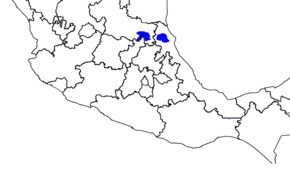와스텍어
와스텍어(Wastek, Huasteco)는 멕시코의 와스텍족이 사용하는 마야어족 언어이다. 산루이스포토시주와 베라크루스주 북부의 시골에서 쓰인다. 메소아메리카의 남쪽 지역에서 쓰이는 다른 마야어족 언어들로부터 지리적으로 외떨어져 있다. 2005년 인구조사에 따르면 멕시코에서 약 20만 명이 와스텍어를 할 줄 안다(산루이스포토시주에 약 12만 명, 베라크루스주에 약 8만 명).[3] 최근에는 테넥어(Teenek)라고도 불리며, 이 이름은 멕시코 국내에서나 국제적으로나 점차 널리 쓰이고 있다.
| 사용 국가 | 멕시코 |
|---|---|
| 사용 지역 | 산루이스포토시주, 베라크루스주, 타마울리파스주 |
| 사용 민족 | 와스텍족 |
| 언어 인구 | 161,120명 (2010년 인구조사)[1] |
| 언어 계통 | 마야어족 와스텍어파 와스텍어 |
| 언어 부호 | |
| ISO 639-3 | hus 와스텍어
|
| 글로톨로그 | huas1242[2] |

| |
| 멕시코의 와스텍어 사용 지역 | |
지금은 사멸한 치코무셀텍어가 가장 가까운 친척이다.
와스텍어 문법을 최초로 기술한 유럽인은 안드레스 데 올모스(Andrés de Olmos)로, 그는 나와틀어와 토토낙어의 문법을 최초로 기술한 사람이기도 하다.
산루이스포토시주 탄칸위츠데산토스에 위치한 라디오 방송국 XEANT-AM이 와스텍어로 된 라디오 방송을 진행하고 있다.
방언
편집와스텍어에는 3개의 방언이 있고 이들이 갈라진 시기는 길어야 400년 전으로 보인다(Norcliffe 2003:3). 멕시코 중동부의 와슈테카-포토시나(Huaxteca-Potossina)라 불리는 지역에서 사용된다.
- 서부 방언(포토시노): 화자 48,000명. 산루이스포토시주의 9개 마을(시우다드바예스, 아키스몬, 웨웨틀란, 탄칸위츠, 탄라하스, 산안토니오, 탐파몰론, 탕키안, 탕콰얄라브)
- 중부 방언(베라크루스): 화자 22,000명. 베라크루스주 북부의 2개 마을(템포랄, 탄토유카)
- 동부 방언(오톤테펙): 화자 12,000명. 베라크루스주 북부의 7개 마을(촌틀라, 탄티마, 탕코코, 치남파, 나랑호스, 아마틀란, 타미아와). 동남 와스텍어라고도 한다. Ana Kondic (2012)의 보고에 따르면 화자가 1,700명밖에 남지 않았으며 이들은 촌틀라, 치남파, 아마틀란, 타미아와에 살고 있다.[4]
음운론
편집모음
편집| 단모음 | 전설 | 중설 | 후설 |
|---|---|---|---|
| 고모음 | i [i] | u [ü] | |
| 중모음 | e [e̞] | o [o̞] | |
| 저모음 | a [a] |
| 장모음 | 전설 | 중설 | 후설 |
|---|---|---|---|
| 고모음 | ii [ʲiː] | uu [ɯː] | |
| 중모음 | ee [eː] | oo [ɤː] | |
| 저모음 | aa [aː] |
자음
편집| 순음 | 치경음 | 경구개음 | 연구개음 | 성문음 | ||||||
|---|---|---|---|---|---|---|---|---|---|---|
| 기본 | 방출 | 기본 | 방출 | 기본 | 방출 | 기본 | 방출 | |||
| 비음 | m [m] | n [n] | ||||||||
| 파열음 | 무성 | pʼ [pʼ] | tʼ [tʼ] | kʼ [kʼ] | ʼ [ʔ] | |||||
| 유기 | t [tʰ] | k [kʰ] | ||||||||
| 유성 | b [b] | |||||||||
| 파찰음 | 기본 | tsʼ [tsʼ] | chʼ [tɕʼ] | |||||||
| 유기 | p [ɸʰ] | ts [tsʰ] | ch [tɕʰ] | |||||||
| 마찰음 | s [s] | z [θ] | x [ʃ] | j [χ] | ||||||
| 접근음 | w [ʋ] | l [l] | y [j] | |||||||
| 탄음 | r [ɾ] | |||||||||
각주
편집- ↑ Instituto Nacional de Lenguas Indígenas (2012), México: Lenguas indígenas nacionales
- ↑ Hammarström, Harald; Forkel, Robert; Haspelmath, Martin; Bank, Sebastian, 편집. (2023). 〈Huastec〉. 《Glottolog 4.8》. Jena, Germany: Max Planck Institute for the Science of Human History.
- ↑ INEGI, 2005
- ↑ “Archived copy” (PDF). 2013년 9월 28일에 원본 문서 (PDF)에서 보존된 문서. 2013년 1월 9일에 확인함.
추가 문헌
편집- Ariel de Vidas, A. 2003. "Ethnicidad y cosmologia: La construccion cultural de la diferencia entre los teenek (huaxtecos) de Veracruz", in UNAM, Estudios de Cultura Maya.Vol. 23.
- Campbell, L. and T. Kaufman. 1985. "Maya linguistics: Where are we now?," in Annual Review of Anthropology. Vol. 14, pp. 187–98
- Dahlin, B. et al. 1987. "Linguistic divergence and the collapse of Preclassic civilization in southern Mesoamerica". American Antiquity. Vol. 52, No. 2, pp. 367–82.
- Edmonson, Barbara Wedemeyer. 1988. A descriptive grammar of Huastec (Potosino dialect). Ph.D. dissertation: Tulane University.
- INAH. 1988. Atlas cultural de Mexico: Linguistica. Mexico City: Instituto Nacional de Antropologia e Historia.
- Kaufman, T. 1976. "Archaeological and linguistic correlations in Mayaland and associated areas of Mesoamerica," in World Archaeology. Vol. 8, pp. 101–18
- Malstrom, V. 1985. "The origins of civilization in Mesoamerica: A geographic perspective", in L. Pulsipher, ed. Yearbook of the Conference of Latin Americanist Geographers. Vol. 11, pp. 23–29.
- McQuown, Norman A. 1984. A sketch of San Luis Potosí Huastec. University of Texas Press.
- (CDI). No date. San Luis Potosí: A Teenek Profile; Summary. Archived from the original on July 17, 2007.
- Norcliffe, Elizabeth. 2003. The Reconstruction of Proto-Huastecan. M.A. dissertation. University of Canterbury.
- Ochoa Peralta, María Angela. 1984. El idioma huasteco de Xiloxúchil, Veracruz. México City: Instituto Nacional de Antropología e Historia.
- Ochoa, L. 2003. "La costa del Golfo y el area maya: Relaciones imaginables o imaginadas?", in UNAM, Estudios de Cultura Maya.Vol. 23.
- Robertson, J. 1993. "The origins and development of Huastec pronouns." International Journal of American Linguistics. Vol. 59, No. 3, pp. 294–314
- Sandstrom, Alan R., and Enrique Hugo García Valencia. 2005. Native peoples of the Gulf Coast of Mexico. Tucson: University of Arizona Press.
- Stresser-Pean, G. 1989. "Los indios huastecos", in Ochoa, L., ed. Huastecos y Totonacas. Mexico City: CONACULTA.
- Vadillo Lopez, C. and C. Riviera Ayala. 2003. "El trafico maratimo, vehiculo de relaciones culturales entre la region maya chontal de Laguna de Terminos y la region huaxteca del norte de Veracruz, siglos XVI-XIX", in UNAM, Estudios de Cultura Maya.Vol. 23.
- Wilkerson, J. 1972. Ethnogenesis of the Huastecs and Totonacs. PhD dissertation, Department of Anthropology and Archaeology, Tulane University, New Orleans.
외부 링크
편집- 바버라 에드몬슨의 와스텍어 자료. 이야기, 단어장, 제례 의식 모음. Archive of the Indigenous Languages of Latin America 수록.